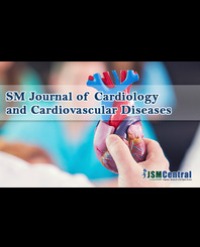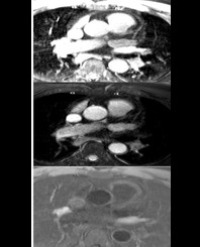Aim: So far, invasive procedures, such as heart catheterization, are state of the art to investigate blood oxygenation levels in humans. For patients who suffer of chronical heart disease and renal failure BOLD (blood oxygenation level dependent) is an effective, but still frail imaging method. This study aimed to validate the use of Magnetic Resonance Imaging (MRI) with a dynamic T2 preparation pulse and a weighted subtraction afterwards as a competitive imaging method to assess blood oxygenation in a phantom and healthy volunteers.
Methods: MRI was performed with a dynamic T2 preparation pulse followed by a weighted subtraction of the dynamic T2 sequences to investigate different blood oxygenation levels in an Extracorporeal Membrane Oxygenation (ECMO) pump (phantom). Afterwards, healthy volunteers (age 30 to 45 years without chronic disease) were enrolled and imaged with identical cardiac MRI protocols. Finally, we compared the oxygenation levels obtained with Blood Oxygenation Level-Dependent (BOLD) imaging and bedside gas analysis with those obtained with the dynamic T2 preparation pulse.
Results: The Signal-to-Noise Ratios (SNRs) of the subtracted images acquired with the T2 preparation pulse sequence for both the phantom and 19 healthy volunteers (mean age 25 ± 10 years) were significantly negatively correlated with the oxygenation level assessed by BOLD imaging (r = -0.6479, p = 0.0227 and r = -0.7754, p < 0.003, respectively). The phantom’s Contrast-to-Noise Ratio (CNR) and the healthy volunteers’ CNRs and SNRs in the ascending aorta and pulmonary artery measured on the T2 images were significantly correlated with the oxygenation level measured by blood gas analysis (p < 0.05). The BOLD imaging and blood gas analysis measurements of the oxygenation level were significantly negatively correlated (r = -0.965, p < 0.008), and the oxygenation levels in the pulmonary artery measured with BOLD imaging demonstrated a positive association with that as assessed by blood gas analysis (p < 0.05).
Conclusion: Non-invasive measurement of blood oxygenation using a dynamic T2 preparation pulse is feasible in healthy patients. Unlike existing state of-the-art methods involving invasive measurements, this method does not require the use of radiation or contrast agents, thus critical patients with renal failure, could be investigated by cardiac MRI in a competitive method to BOLD. Further work is necessary to validate this technique in a clinical setting.
Translational Perspective: The dynamic T2 preparation pulse MRI sequence is able to distinguish between oxygenated and deoxygenated blood with little effort without the need for radiation or contrast agents and can therefore be implemented in clinical settings.
Britta Elkenhans1*, Ingmar Vieregge2, Tienush Rassaf3, Markus Henningsson4, Tarique Hussain5, Gerald Greil5 and Rene Botnar6




